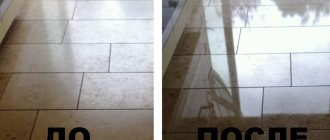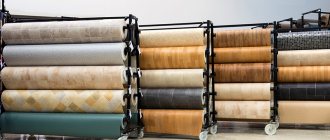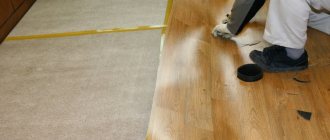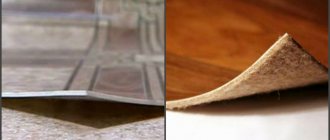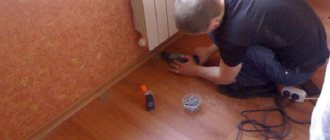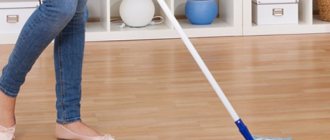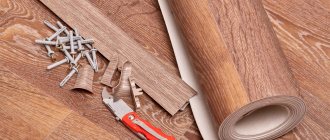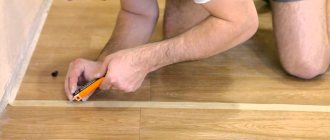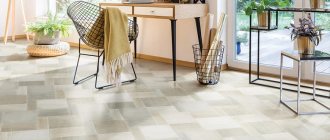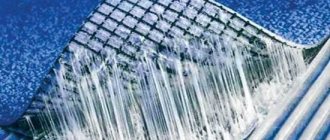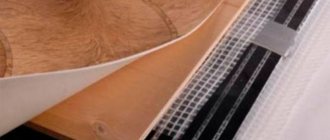Among the many existing floor coverings, linoleum is especially popular. It is chosen because of a number of advantages: a large number of different designs, affordable price, easy installation method, sufficient strength. However, many housewives are faced with the problem of yellow spots appearing on the surface of linoleum. There may be several reasons for this phenomenon:
- Poor quality coating.
- In production where they want to save money, they often produce linoleum without the necessary protective coating, which affects its strength.
- External influences.
Housewives notice that yellow stripes appear where people walk most often. Also, damage and discoloration may appear after using aggressive detergents containing alkalis, soda, and chlorine. The exception is bleach; it can be used, but in a very small percentage. Since this method is quite dangerous for coating, it is recommended to resort to it only in extreme cases. Yellowness appears, for example, from shoe polish, bitumen, paraffin, paint and other substances.
However, getting rid of defects of this kind on linoleum is not so difficult. There are many ways: from special detergents to using boiled potatoes. Let's talk about five of the simplest and most budget-friendly ones.
Special means
First of all, you should try special cleaning products such as Mr. Muscle, Glorix and others that do not contain alkalis, soda and chlorine. They should not be applied in their pure form, as this may aggravate the situation. The product dissolves in water, and only after that you can start washing the floors. The advantage of this method is its high availability: household chemicals are sold in many stores and have a relatively low price, while they are quite effective.
for cleaning floors
How to remove yellowness from linoleum
moderator chose this answer as the best
Kim Jong-un [357K]
Usually old linoleum that is laid in places with high traffic (a corridor, for example) turns yellow.
If new linoleum turns yellow, then it is a low-quality material, or defective.
And it turns yellow because in the production process of linoleum, special substances (plasticizers) are used, which give the material that same elasticity.
Plasticizers are found in the top layer of the material; people wear shoes on the linoleum; there may be dust, dirt, or other contaminants on the surface of the linoleum; all this reacts with those same plasticizers and as a result we get that same yellowness on the surface.
It is useless to fight, the yellowness is not on the surface, it is much deeper, it’s time to change the coating, or somehow decorate the problem area (for example, lay down a rug).
Yellowness is not fought after the fact; only measures taken in advance work here.
There are special acrylic polishes for linoleum on sale,
they create a protective film on the surface, which protects the coating from yellowing as well.
The fact is that linoleum mainly consists of polymers and various modifiers, in particular antioxidants. Under the influence of atmospheric oxygen, antioxidants are gradually activated and the plastic base of linoleum begins to oxidize. This process is accelerated under the influence of aggressive chemical compounds, such as organic solvents, alcohols, etc. So to increase the service life of linoleum, it is necessary to avoid exposure to aggressive chemical compounds, as well as exposure to high temperatures and, if possible, direct sunlight. And also take care of linoleum and cover it with protective polishes.
This polish will be enough and your linoleum will serve you longer and not turn yellow.
As a rule, if the linoleum is good, that is, it meets all the necessary quality standards, then it will turn yellow over the years. But if you purchased cheap linoleum, the production of which did not comply with the standards and GOSTs, then you may encounter this problem very soon after the purchase.
Remember the rules for this material:
- linoleum cannot be washed with hot water, or with the addition of soda or ammonia;
- It is best to use warm water with the addition of laundry soap when washing;
- after washing, you need to wipe the linoleum dry;
- Once every three months, wipe it with natural drying oil, then dry thoroughly with a soft cloth.
Yellowing of linoleum can occur due to the fact that lipstick, alcohol-containing products, shoe polish, sand, and street dirt have come into contact with it. Prolonged contact with rubber also causes yellowing. Experience shows that it is almost impossible to remove yellow stains on linoleum. Most likely, it will have to be changed again.
The yellowness of the linoleum indicates that dirt has started to get inside or bacteria have started to appear. The yellowing process is practically unstoppable, so all efforts will be in vain.
Leave the wet linoleum for 15 minutes, and then rinse the floor with fresh water.
The elasticity of linoleum is achieved thanks to plasticizers, substances included in the composition of polymer materials. It is these plasticizers, when interacting with our shoes, that absorb the microparticles of dyes contained there, which leads to yellowing. As elsewhere, preventing the appearance of yellow spots is easier than treating. And it’s quite easy to prevent it by simply applying acrylic polymer films.
Shadowhunter [252]
Linoleum turns yellow from constant exposure to sunlight and moisture. This process also comes from constant walking on it. You cannot stop the process; you will not return it to its previous appearance. In the future, try to wash it more often with the addition of surface cleaning products.
Linoleum is a practical and popular flooring that can be installed in any living area, be it a living room or a kitchen. During use, the material gets dirty and loses its original appearance. If you know how to wash linoleum and what products to use, you can protect the material from damage and keep it in good condition for many years.
How to care for linoleum?
There are certain rules for cleaning different types of linoleum
Linoleum can be natural or made from artificial fibers (PVC). Material made from natural components is considered stronger, but care and precautions are the same for both types of coating. There are several preventive measures that, if followed, can avoid premature deterioration of the material:
- Avoid prolonged contact of linoleum with direct sunlight. Because of this, the coating loses its brightness.
- The material deteriorates from high temperatures, so it is better to clean it with water at 30-35 degrees.
- Artificial linoleum does not like excess moisture. After washing the floors, remove excess water with a dry cloth.
- If bleaches containing chlorine are used for cleaning, they are diluted with water 50:50. Concentrated products cause color loss and possible staining.
- To prevent mechanical damage, special stickers are applied to the legs of heavy furniture.
- It is not recommended to lay linoleum on uninsulated loggias. This leads to the fact that the material begins to deteriorate, deform, and cracks and damage appear.
- Do not use abrasive cloths or powders with large, hard granules for cleaning. After their use, the surface deteriorates and gets scratched.
- If dyes come into contact with linoleum, they must be removed from the surface immediately. Once absorbed, cleaning is extremely difficult.
- It is not recommended to use cleaning products that contain kerosene, acetone and other aggressive substances.
- Before entering the room, lay a rug to clean the soles from dirt that scratches the linoleum.
To extend the service life of the material, it is treated with a special polish or mastic. After applying the compositions, a thin film is formed that protects the linoleum from external damage, ultraviolet irradiation and premature abrasion. The processing principle is as follows
It would be useful to treat linoleum with transparent drying oil or natural linseed oil. The procedure is carried out 1-2 times a month and helps prevent the occurrence of cracks.
Note. Drying oil is divided into natural, composite and oxol. For linoleum laid in residential premises, a product based on natural ingredients is used. Composite drying oil is intended for external use only, as it is toxic and can cause harm to the body. Oxol is not recommended to be applied to linoleum, because it contains a solvent that has a detrimental effect on the floor covering.
Cleaning methods
The material is cleaned not only in specialized dry cleaning establishments, but also at home. The main thing is to know what you can use to clean linoleum without causing further harm, and to follow some care tips. There are two types of cleaning:
- Dry - carried out using a vacuum cleaner. In the first 5 days after laying linoleum, it is recommended to eliminate contamination using this method, because moisture on the surface of newly laid linoleum is undesirable. Also, the dry method is suitable for quick daily cleaning and does not take much time.
- Wet - using detergents. Before starting cleaning with this method, particles of dirt are removed from the surface of the linoleum using a broom or vacuum cleaner. Then a special cleaning solution is added to a container with warm water, a soft cloth or sponge is moistened in it, and the linoleum is washed.
At home, liquid soap is most often used to prepare a soap solution. It is not recommended to use powder, but there are situations when contaminants need to be removed urgently, and there is nothing else at hand. Then 1 tbsp. l of powder is dissolved in 3 liters of warm water so that no solid particles remain, and only after that the floor covering is cleaned.
If these products cannot remove stains and any dirt, then it is best to purchase special cleaning compounds for natural or artificial linoleum in the store. It is important to use such products following the instructions; if diluted incorrectly, you can harm the coating and ruin it.
Cleaning linoleum after repair
Cleaning linoleum after repair
How to clean linoleum after repair is one of the most frequently asked questions. Whitewash, paint and mortars do not wipe off the surface of the material very well, but there are still ways to remove contaminants. These include:
- Soap solutions with the addition of table salt (5-6 tbsp per 10 liters of water). The floor is washed with this composition 2-3 times and then washed off with clean water.
- Water with potassium permanganate (1/6 tsp manganese per 10 liters of water). It is important that the crystals dissolve completely, as they leave stains on the linoleum.
The dried paint is removed with a spatula, then the remaining stain is wiped with white spirit, and after that the floor covering is washed with clean water.
Cleaning stubborn stains and yellow discoloration
Linoleum has turned yellow - how to clean it at home? If the floor covering has turned yellow from age, then, unfortunately, such yellowness cannot be completely removed. You can lighten it a little and refresh the linoleum. For this purpose in 10 l. 1 liter of warm water is added. whiteness, then the floor is washed with the solution 2-3 times. After bleaching, the floor covering is thoroughly washed with clean water. Finally, the linoleum is rubbed with a special polish, which can be glossy or matte. For old flooring, the first option is more suitable. Gloss refreshes the color and creates a visual effect of newness of linoleum. The table below presents folk remedies and descriptions of how to wash old linoleum from difficult to remove stains:
Before you begin cleaning stains, you should test the cleaner in an inconspicuous area of the linoleum. If, after applying the composition, white spots, stains remain, or small bubbles form on the surface of the coating, then it should not be used under any circumstances. In this case, you will have to select another remedy. Most often, such problems can arise with artificial material. Natural linoleum is more resistant to cleaning mixtures. In addition, it is important to remember that when removing stains, do not rub the surface of the flooring too hard. This leads to abrasion of the material, the appearance of streaks and lightened spots.
Important! All procedures are performed with rubber gloves. Aggressive agents harm the skin. If the composition does get on the skin, you should rinse the affected area under running water.
Eraser
Black streaks from shoes at the front door are a fairly common problem. It is difficult to get rid of it using traditional detergents, so a stationery eraser comes to the rescue in this situation. It quickly copes even with stubborn dirt.
Shoe marks can be easily erased with an eraser
To eliminate dark streaks, you need to rub an eraser over them, and then remove the residue with a dry cloth and wash the linoleum with soapy water. In addition, chewing gum is removed in this way. To do this, follow the instructions:
- Apply an ice cube to the chewing gum for 2-3 minutes.
- Carefully remove dirt with a knife.
- Wipe off any remaining chewing gum with an eraser.
- Wash the linoleum with soapy water.
- Dry the surface of the floor covering with a dry cloth.
The eraser helps get rid of green stains, grease, iodine, coffee and other contaminants. If this method does not help, then you will have to turn to help, alcohol, vinegar or solvents.
Vodka
It is considered an effective remedy for many types of pollution and unpleasant odors. Most often, solutions with vodka or alcohol are used to remove grease, felt-tip pen and ink. The funds are prepared in three ways:
- Mix 1 liter of warm water, 1 teaspoon of dishwashing liquid and 200 ml of vodka or 2 tbsp. l medical alcohol.
- Add 1 tsp of soda and 50 ml of vodka to 200 ml of water. Place 1 liter of warm water in a container, add 200-250 ml of vodka and 1 tbsp. l lemon juice.
Cotton wool is soaked in the resulting solution, which is then applied to the contaminated area. If the contamination is ingrained, then the exposure time of the product is 30-40 minutes. Remaining dirt is removed with a clean cloth, and then the surface of the linoleum is washed with clean water. Sometimes you can't get stains off the first time. Then the procedure is repeated 1 or 2 more times.
Note. It is forbidden to use sponges with abrasives, as they will deteriorate the linoleum and leave scratched white spots that cannot be removed.
Vinegar
- Moisten the contaminated area.
- Pour 1 tbsp. l table salt.
- Wait 5-10 minutes (depending on the degree of contamination).
- Remove residues with a sponge.
- Wash the linoleum thoroughly with soapy water and then with clean water.
- Dry the floor covering with a dry cloth.
It is important to remember that work is carried out only with rubber gloves. If vinegar gets on the skin, severe burns occur.
The video shows how to clean old linoleum and what cleaning products are used at home.
Folk way
It is also worth trying several traditional methods that can cause minimal financial costs. The first method and, as practice shows, one of the most effective is a mixture of soap, water, vodka (about two hundred milliliters per half bucket of water) and a small amount of dishwashing detergent. Wash the floor with this solution, paying special attention to problem areas. After that, you need to wipe it with a dry cloth and wash the floor with clean warm water to get rid of the alcohol smell on the floor.
Types of pollution
Another important fact for successfully removing stains from linoleum is determining their type and origin, this will make it easier to choose a product. The options are varied, but the most common are:
- Oily spots.
- Traces of food: mayonnaise, ketchup, mustard.
- Traces of rust, iodine, mold, brilliant green.
- Marker drawing, ink drops.
- Contaminants of unknown origin. Most often these are pinkish or red spots. If they appear on linoleum, then the fight against them will be long and persistent.
Vinegar
The riskiest method is to add a small amount of vinegar to a bucket of water. If you use vinegar in its pure form, you can ruin the coating, so you should be careful if you use this method.
vinegar
There are other ways to remove yellow spots and streaks on the surface of linoleum. It’s better to take care of its quality even at the acquisition stage, so you can save both time and money. In addition, you should handle the coating with care. For example, in places where people often walk, you can lay a carpet or use special varnishes and enamels that cover the linoleum with a protective film, which makes the coating more durable.
Another option
You can remove yellow marks from your flooring with a simple home remedy. It is made from baking soda and water. You will also need a soft cloth. The procedure is performed in stages. First, dirt is removed from the surface of the linoleum. Then the problem area is moistened with plain water. Next, sprinkle the yellow spots with baking soda and leave for 10-15 minutes. After this time, check the result. If it is unsatisfactory, then let the soda react with the yellow spots for another five minutes. Afterwards, you will need to use a soft cloth to remove the remnants of this product. It is possible that after some time the yellowness will return. Therefore, when performing weekly cleaning, do not forget to also treat linoleum with baking soda for preventive purposes.
Helpful cleaning tips
Before you start cleaning linoleum from old or fresh stains, it is advisable to familiarize yourself with the following recommendations:
No one can say how one or another cleaning agent will affect a particular PVC material. In order for the cleaning process to be successful and new stains not to form on the treated surface, the purchased chemical must be tested in an inconspicuous area (somewhere under the sofa, crib).
Causes of yellow spots
Yellowed spots on linoleum appear for various reasons. They can occur on both new and old coatings. But they will appear depending on different conditions. Before deciding how to wash light linoleum from yellowness, you should understand the reasons for its appearance.
The reason for the appearance of such spots can be:
The simplest reason for yellowing of linoleum can be the period of use. It's just time to replace the old coating with a new one.
